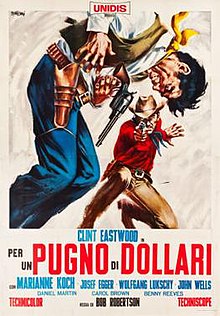When it comes to the Western genre, you would figure it’s the most American of film styles. However, the irony is that some of the most recognizable Western films were in fact made by an Italian. This sub-category of the Western theme is known as the Spaghetti Western. Because they were directed by Italians, the “Spaghetti” designator helps to distinguish between these films and American Westerns. The one Director who made his mark on this genre is none other than Sergio Leone. Even though his filmography was short, of the 10 films he directed, seven of them were Westerns. His style is now seen as the classic form of the 1960s Western, which was a departure from the American Westerns of the 1950s, both in visuals and content. This week we will examine two of Sergio Leone’s Spaghetti Westerns, the first two parts of the “Dollars Trilogy.”
A Fistful of Dollars
Year: 1964
Rating: R
Length: 99 minutes / 1.65 hours
A Fistful of Dollars (1964) heralded the start of many things. Not only did it begin the Spaghetti Western genre and start the “Man with No Name” trilogy, but it initiated Clint Eastwood on his successful film career. Even though Eastwood and Leone had a bit of a falling out after their three films together, Eastwood was influenced by Leone as a Director, a point made clear in his Oscar-winning Western, Unforgiven (1992). What is interesting about this film is that it was actually inspired by the Japanese film, Yojimbo (1961), directed by Akira Kurosawa three years earlier. Strangely enough, even with Japanese influences on a traditionally American genre, A Fistful of Dollars has become a universal cultural icon, even being parodied in Back to the Future Part III (1990), as well as an episode of the T.V. show, Community.
In the small town of San Miguel, two rival families have been making a fortune in selling illegal whiskey and rifles. There is a tenuous peace until the Man with No Name (Clint Eastwood) rides into town. He sees an opportunity to grab quite a few fistfuls of dollars by escalating their rivalry. He starts by killing a few of the Baxters, offering his services to the Rojos. Swapping back and forth between each side, the Stranger eventually goes too far by letting a prisoner of the brutal Ramon Rojo (Gian Maria Volonté) escape to her family. Ramon finds the Stranger and beats him half to death. As he recovers from his injuries, he prepares to take on the Rojos, and especially the frenzied Ramon. With some hidden body armor, the Stranger faces Ramon and the rest of the Rojo gang, skillfully outshooting them all. His business in town now finished, the Stranger leaves as quietly as he arrived.
For a Few Dollars More
Year: 1965
Rating: R
Length: 132 minutes / 2.2 hours
After finishing the “Dollars Trilogy” with The Good, the Bad, and the Ugly (1966), Sergio Leone directed four more Spaghetti Westerns, the best-known of which was Once Upon a Time in the West (1968). His final film, Once Upon a Time in America (1984), was in line with this naming convention but was a departure from the Spaghetti Western genre. What’s interesting is the difference between the Spaghetti Western and the American Western. Leone was fed up with the unbelievable, stale, and moralistic plots of the Western and went about to change it. With his excellent camera work involving lots of detail, close-ups, and wide shots, Leone set the stage for future Spaghetti Westerns. Of course, with this trilogy, we can’t forget about the iconic music composed by Ennio Morricone, which is now whistled throughout the world.
The second installment in the trilogy, For a Few Dollars More (1965) finds the money-focused Man with No Name (Clint Eastwood) as a bounty hunter in the Southwest. Unfortunately, he has some competition from a former Confederate officer, Colonel Douglas Mortimer (Lee Van Cleef). When a bounty on the outlaw Indio (Gian Maria Volonté) for $10,000 appears, both men set out to collect. Once they find they are after the same man, they decide to team up. The Man with No Name infiltrates Indio’s gang while Col. Mortimer lies in wait. After the Stranger double-crosses Mortimer, he is surprised to find the other bounty hunter deduced this betrayal and has shown up at the gang’s hideout. Vengeance drives Mortimer, and soon he is able to avenge his sister in a shootout between him and Indio. With the gang in a heap, the Man with No Name rides off to collect the bounties.
2 sum it up: 2 films, 2 spectacular Sergio Leone Spaghetti Westerns
Bacon #: 3 (An Almost Perfect Affair / Christian De Sica -> Natale a Miami / Marc Macaulay -> Wild Things / Kevin Bacon)

